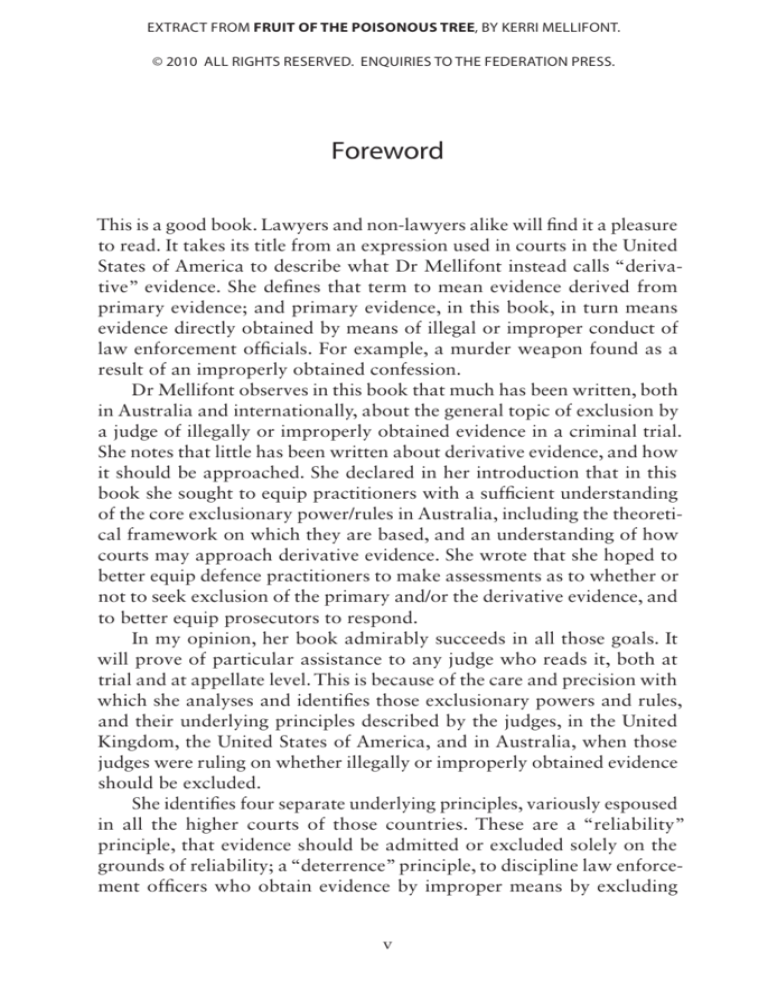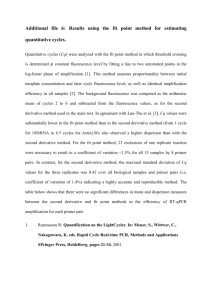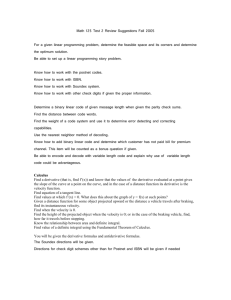
Extract from Fruit of the Poisonous Tree, by Kerri Mellifont.
© 2010 All rights reserved. Enquiries to The Federation PreSS.
Foreword
This is a good book. Lawyers and non-lawyers alike will find it a pleasure
to read. It takes its title from an expression used in courts in the United
States of America to describe what Dr Mellifont instead calls “derivative” evidence. She defines that term to mean evidence derived from
primary evidence; and primary evidence, in this book, in turn means
evidence directly obtained by means of illegal or improper conduct of
law enforcement officials. For example, a murder weapon found as a
result of an improperly obtained confession.
Dr Mellifont observes in this book that much has been written, both
in Australia and internationally, about the general topic of exclusion by
a judge of illegally or improperly obtained evidence in a criminal trial.
She notes that little has been written about derivative evidence, and how
it should be approached. She declared in her introduction that in this
book she sought to equip practitioners with a sufficient understanding
of the core exclusionary power/rules in Australia, including the theoretical framework on which they are based, and an understanding of how
courts may approach derivative evidence. She wrote that she hoped to
better equip defence practitioners to make assessments as to whether or
not to seek exclusion of the primary and/or the derivative evidence, and
to better equip prosecutors to respond.
In my opinion, her book admirably succeeds in all those goals. It
will prove of particular assistance to any judge who reads it, both at
trial and at appellate level. This is because of the care and precision with
which she analyses and identifies those exclusionary powers and rules,
and their underlying principles described by the judges, in the United
Kingdom, the United States of America, and in Australia, when those
judges were ruling on whether illegally or improperly obtained evidence
should be excluded.
She identifies four separate underlying principles, variously espoused
in all the higher courts of those countries. These are a “reliability”
principle, that evidence should be admitted or excluded solely on the
grounds of reliability; a “deterrence” principle, to discipline law enforcement officers who obtain evidence by improper means by excluding
v
Foreword
that evidence, to discourage future impropriety; a “rights protection”
principle, based on the idea that courts should uphold the rights of the
accused in the criminal justice system; and a “judicial integrity” principle,
that illegally or improperly procured evidence should be excluded if
its admission would undermine the integrity and legitimacy of the
administration of justice.
Dr Mellifont then considers – based on a review of decided
cases – how the consistent application of each principle might produce
different results, when applied to primary and derivative evidence. She
does this for derivative confessional evidence (a second or subsequent
confession) and for derivative real evidence (a murder weapon etc). She
does this for both the common law and statutory regimes in the United
Kingdom and Australia [the Police and Criminal Evidence Act 1968
(UK) and the Uniform Evidence Legislation in Australia] and for the
United States in respect of cases based on the Fourth, Fifth, Sixth and
Fourteenth Amendments to the Bill of Rights annexed to the United
States Constitution.
Her lengthy chapter on the American experience with derivative
evidence and excluded evidence is particularly interesting. She explains
and traces the development of a set of somewhat preemptory exclusion rules, based on enshrined rights, leading to the seminal decision in
Miranda v Arizona (1966). That in turn was followed by the development of certain exceptions to those rules, allowing in derivative evidence,
often confessional. She describes these with self-explanatory terms – the
good faith exception, the independent source exception, the inevitable
discovery exception, and the purged taint exception. In her concluding
chapter, she warns against too readily adopting these, as they seem to
lead to the view that police investigators are given the benefit of an
assumption that they could have lawfully achieved whatever results
flowed from unlawful investigations.
Dr Mellifont’s analysis identified repeated common threads in
all three jurisdictions. It certainly provides a reader with a sufficient
understanding of the core exclusionary powers and rules in Australia.
She describes the historical development in Australia of a judicial
power to exclude evidence, identifying the basis of those discretionary
powers, and those limited to a power to exclude confessional evidence.
She describes the well established discretion to exclude illegally or
improperly obtained evidence, on public policy grounds – by balancing
the public interest in convicting offenders against the public interest in
vi
Foreword
discouraging unlawful conduct by policy – (the “public policy” discretion) as now being based on the judicial integrity principle. In that regard,
she cites the High Court decision in Ridgeway v The Queen (1995) 184
CLR 19. She remarks this description of the “public policy” discretion
and its underlying basis may have consequences for the admissibility of
derivative evidence, both real and confessional.
She makes three concrete suggestions for lawyers grappling with
derivative evidence issues. I agree with two of these. The first is that a
court should identify and prioritise the principles said to underlie the
exclusionary power being exercised. The second is that courts considering derivative confessional evidence should consider whether the accused,
when making any second or subsequent confession, then knew that he/
she did not have to speak, notwithstanding that an earlier confession
had already been given, and whether the accused was informed that any
earlier confession might not be admissible.
The third recommendation, with which I respectfully disagree, is
that where a confession is excluded under any of the confession specific
exclusionary powers (such as the “fairness” discretion described in
McDermott v The King (1948) 76 CLR 501), the court should hypothetically determine what the fate of the confession would have been under
the “public policy” discretion and then approach the derivative evidence
accordingly.
This suggestion reflects the author’s acceptance that the public policy
discretions at common law and under s138 of the Uniform Evidence
Legislation apply to all types of evidence and provide appropriate criteria by which the exclusion or admission of derivative real evidence from
improperly obtained confessions should be considered. That was the
position declared in Queensland in R v Scott; ex parte Attorney-General
[1993] 1 Qd R 537. That decision highlighted the importance of a court
identifying the particular power used to exclude evidence, such as a
confession, but also emphasized that it did not follow that derivative
evidence should have the same fate, even if a confession may have been
excluded on other grounds as well.
I commend this work to lawyers, scholars, and general readers.
J A Jerrard
BA, LLB, LLM.
vii








